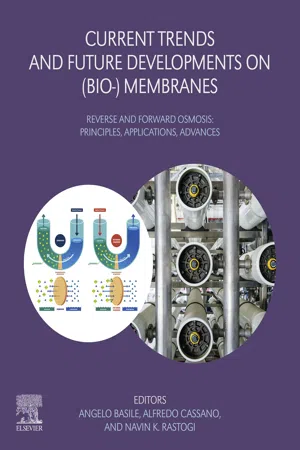
Current Trends and Future Developments on (Bio-) Membranes
Reverse and Forward Osmosis: Principles, Applications, Advances
- 366 pages
- English
- ePUB (mobile friendly)
- Available on iOS & Android
Current Trends and Future Developments on (Bio-) Membranes
Reverse and Forward Osmosis: Principles, Applications, Advances
About This Book
Current Trends and Future Developments on (Bio-) Membranes: Reverse and Forward Osmosis: Principles, Applications, Advances covers the important aspects of RO, FO and their combination in integrated systems, along with their specific and well-established applications. The book offers an overview of recent developments in the field of forward and reverse osmosis and their applications in water desalination, wastewater treatment, power generation and food processing. General principles, membrane module developments, membrane fouling, modeling, simulation and optimization of both technologies are also covered. The book's ultimate goal is to support the scientific community, professionals and enterprises that aspire to develop new applications.
- Provides an overview of the advances made in combining reverse osmosis membrane technology and the corresponding forward osmosis
- Provides a comprehensive review of advanced research on membrane processes for water desalination, wastewater treatments, etc.
- Addresses key issues in process intensification and extraction of energy from renewable sources
- Identifies further research needs for the practical implementation of these two membrane technologies
Frequently asked questions
Information
Forward osmosis: Principles, applications, and recent developments
Abstract
Keywords
Acknowledgments
1 Introduction
- • Retention of fresh fruit flavor and nutritional/bioactive components
- • Minimum color degradation and improved product quality
- • Concentration at ambient pressure and temperature
- • Absence of thermal effects, so cooked taste is not imparted to the food
- • Reduction in membrane fouling propensity over pressure-driven membrane processes
- • Use of simple equipment and energy efficiency
Table of contents
- Cover image
- Title page
- Table of Contents
- Copyright
- Contributors
- Preface
- Part 1: Forward osmosis
- Part 2: Reverse osmosis
- Part 3: Integrated RO/FO
- Index